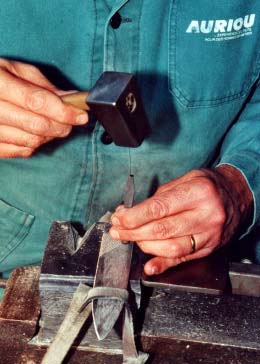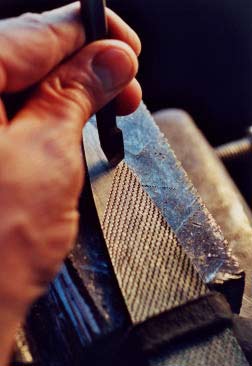On The History and Manufacture Of Rasps
Click here for more information on using rasps.
Click here to see our entire range of Auriou rasps
For Gramercy rasps click here, here, and here

The File in History -1922)


The Nickolson #49 and #50 patternmaker's rasps are two exceptions to the machine-made rule. They are the last gasp of Nicholson's line of top-quality, random-cut rasps. They are machine-made, but the machine in question is a special gizmo that, using extensive skilled operator control, allows for minute adjustment in the position of the teeth so that the resulting spacing is slightly random, like a hand-cut rasp. These rasps cut very fast and very smoothly. They're more expensive than rasps that are totally machine made, but they work almost as well as much more expensive hand-made tools. The one hitch is that these two styles - the #49 and its finer cut cousin, the #50 - are the only two styles of Nickolson patternmaker's rasps currently being made. They're are great tools and we recommend them highly, but sometimes you need other shapes and these won't suffice.

There are a few other makers of hand made riffler rasps in the world. However none of them are currently producing any tool anywhere near the quality of the Auriou rasps.
Tooth shape
The tooth of a classically hand-made rasp is pointed and will cut cleanly. The teeth of a Nicholson #49 or #50 are similar but flatter on top. They also cut cleanly. On cheaper rasps and r?ffler rasps it is easy to see crushed teeth that were mishandled during the straightening process. Another problem with poorly made hand made rasps is that the teeth aren't even so you get scratches. The finess of cut is proportional to the size of the teeth. The speed of cut is mostly proportional to the density of teeth ion the rasp. Fine rasps should be covered in perfectly even smaller teeth. Coarse rasps should also be covered perfectly even larger teeth.
Modern Makers
There have been no makers of hand-made rasps or riffler rasps in the United States for a long time. Nicholson has moved it's production out of the US and the quality of the 49 and 50 rasps has gone considerably down. Auriou rasps and rifflers, which we do stock are totally hand made by a factory started in 1856, currently with Michel Auriou at the helm. A huge range is available, even the coarse grades for stone-work cut very, very quickly and smoothly, but they are expensive. They are made in the classic French style, with all the rasps and rifflers coming to a point for maximum versatility and the teeth are densely space, pointed and not broken off. Fortunately they will last a long time and are well worth the investment in time saved while using them and the smoothness of cut will save a lot of finishing time. We also stock Gramercy Tools rasps which we designed and are made for us by a single maker in Pakistan, which has a long tradition of metalwork. We handle the rasps here.
|
Hours: M-F 9:00-5:00, closed Sat,Sun Our Guarantee & Return Policy Shipping and Sales Tax Info Privacy Policy Holiday Calendar |
|
Contact Us:
Email: support@toolsforworkingwood.com Phone: 800-426-4613 or 718-499-5877 Visit Us in Brooklyn: Directions to Our Showroom © 1999-2019 toolsforworkingwood.com Powered by 01 Inc. Coded entirely in NYC |


